Quantifying Memories: Mapping Urban Perception
Author(s)
Yoshimura, Yuji; He, Shan; Hack, Gary A; Nagakura, Takehiko; Ratti, Carlo
Download11036_2020_1536_ReferencePDF.pdf (1.578Mb)
Open Access Policy
Open Access Policy
Creative Commons Attribution-Noncommercial-Share Alike
Terms of use
Metadata
Show full item recordAbstract
This paper discusses the relationship between the spatial structure of the built environment and people’s memory of the city as derived from their perceptual knowledge. We explore how spatial comprehension is influenced by the spatial layout pattern in urban settings and individuals’ daily activities. In doing so, we seek to determine whether better spatial knowledge is a function of the legibility of the city and of temporal factors, particularly the amount of time spent in a place. For this purpose, we created a web-based visual survey in the form of a geo-guessing game. The participants were asked to guess the locations of random street views within a familiar neighborhood by placing a pin on a map. This system enabled us to measure how well they remember different urban images on the basis of two indicators of spatial familiarity: location identification and visual recognition. Thus, the resulting datasets are quantitatively different from those collected manually by traditional techniques. By analyzing the combination of the quantitative and qualitative datasets, our proposed methodology can clarify previously unknown aspects of the cognitive role in exploring the built environment and on hidden patterns embedded in the relationship between the city’s spatial elements and people’s mental maps.
Date issued
2020-05Department
Massachusetts Institute of Technology. SENSEable City Laboratory; Massachusetts Institute of Technology. Department of Urban Studies and Planning; Massachusetts Institute of Technology. Department of ArchitectureJournal
Mobile Networks and Applications
Publisher
Springer Science and Business Media LLC
Citation
Yoshimura, Yuji et al. "Quantifying Memories: Mapping Urban Perception." Mobile Networks and Applications 25, 4 (May 2020): 1275–1286. © 2020 Springer Science Business Media, LLC
Version: Author's final manuscript
ISSN
1383-469X
1572-8153